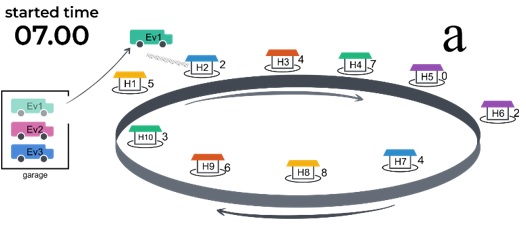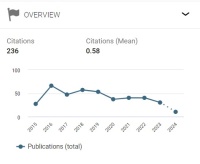Optimization of Electric Bus Scheduling Using Genetic Algorithm: A Case Study in Public Transport of UNNES Campus Area
Abstract
The transportation service system requires improvements to evolve into a smart and more efficient system. Passengers waiting at bus stops can create long queues, causing a lack of available shuttle bus capacity when arriving at the bus stop. This work proposes a genetic algorithm model to minimize passenger waiting time and schedule shuttle buses to stops with high capacity. The Genetic Algorithm works by searching for the optimal value to result in optimal waiting time by providing calling shuttle bus. After the method reaches the optimal solution, the simulation result will provide a minimum waiting time. In case studies of simulated design at either campus in Central Java, Indonesia. This method provides a simulated system shuttle bus on scheduling to raise a challenge in waiting time efficiency and passenger accumulation at campus transportation. The case studies of the application on passenger waiting time showcase the model's ability to improve transportation services in the unscheduled campus area. This system was designed to ensure that it was effective in addressing the transportation challenges faced by students and staff. Use the full potential of bus transportation in the campus area to ensure continuity between stops and city transportation. Therefore, this approach reduces waiting times and schedules to overcome challenges posed by passenger accumulation for structured campus transportation services.
Keywords—Shuttle Bus; Genetic Algorithm; Campus Area; Minimize Waiting Time; Scheduling; Optimization.
Downloads
References
[1] Y.-H. Kuo, J. M. Y. Leung, and Y. Yan, “Public transport for smart cities: Recent innovations and future challenges,” Eur J Oper Res, vol. 306, no. 3, pp. 1001–1026, May 2023, doi: 10.1016/j.ejor.2022.06.057.
[2] K. Gkiotsalitis, “A model for the periodic optimization of bus dispatching times,” Appl Math Model, vol. 82, pp. 785–801, Jun. 2020, doi: 10.1016/j.apm.2020.02.003.
[3] E. Köksal Ahmed, Z. Li, B. Veeravalli, and S. Ren, “Reinforcement learning-enabled genetic algorithm for school bus scheduling,” J Intell Transp Syst, vol. 26, no. 3, pp. 269–283, May 2022, doi: 10.1080/15472450.2020.1852082.
[4] B. Shehu and M. MEng, “DEVELOPMENT OF OPTIMAL BUS SCHEDULE FOR BOSSO AND GIDAN-KWANO CAMPUSES, FEDERAL UNIVERSITY OF TECHNOLOGY, MINNA USING GENETIC ALGORITHM,” 2022.
[5] D. Gura, I. Markovskii, N. Khusht, I. Rak, and S. Pshidatok, “A Complex for Monitoring Transport Infrastructure Facilities Based on Video Surveillance Cameras and Laser Scanners,” Transportation Research Procedia, vol. 54, pp. 775–782, 2021, doi: 10.1016/j.trpro.2021.02.130.
[6] H. Zhang and X. Lu, “Vehicle communication network in intelligent transportation system based on Internet of Things,” Comput Commun, vol. 160, pp. 799–806, Jul. 2020, doi: 10.1016/j.comcom.2020.03.041.
[7] I. G. A. M. Y. Mahaputra, I. G. A. P. R. Agung, and L. Jasa, “Rancang Bangun Sistem Keamanan Sepeda Motor Dengan GPS Tracker Berbasis Mikrokontroler dan Aplikasi Android,” Majalah Ilmiah Teknologi Elektro, vol. 18, no. 3, p. 361, Dec. 2019, doi: 10.24843/MITE.2019.v18i03.P09.
[8] J. Tang, Y. Yang, W. Hao, F. Liu, and Y. Wang, “A Data-Driven Timetable Optimization of Urban Bus Line Based on Multi-Objective Genetic Algorithm,” IEEE Transactions on Intelligent Transportation Systems, vol. 22, no. 4, pp. 2417–2429, Apr. 2021, doi: 10.1109/TITS.2020.3025031.
[9] H. (Harrison) Jeong, Y. (Chris) Shen, J. (Paul) Jeong, and T. (Tom) Oh, “A comprehensive survey on vehicular networking for safe and efficient driving in smart transportation: A focus on systems, protocols, and applications,” Vehicular Communications, vol. 31, p. 100349, Oct. 2021, doi: 10.1016/j.vehcom.2021.100349.
[10] E. Cipriani, G. Fusco, S. M. Patella, and M. Petrelli, “A Particle Swarm Optimization Algorithm for the Solution of the Transit Network Design Problem,” Smart Cities, vol. 3, no. 2, pp. 541–555, Jun. 2020, doi: 10.3390/smartcities3020029.
[11] K. Gkiotsalitis, O. A. L. Eikenbroek, and O. Cats, “Robust Network-Wide Bus Scheduling With Transfer Synchronizations,” IEEE Transactions on Intelligent Transportation Systems, vol. 21, no. 11, pp. 4582–4592, Nov. 2020, doi: 10.1109/TITS.2019.2941847.
[12] S. K. Fayyaz, X. C. Liu, and R. J. Porter, “Dynamic transit accessibility and transit gap causality analysis,” J Transp Geogr, vol. 59, pp. 27–39, Feb. 2017, doi: 10.1016/j.jtrangeo.2017.01.006.
[13] A. Ceder, “Optimal Multi-Vehicle Type Transit Timetabling and Vehicle Scheduling,” Procedia Soc Behav Sci, vol. 20, pp. 19–30, 2011, doi: 10.1016/j.sbspro.2011.08.005.
[14] Y. Xuan, J. Argote, and C. F. Daganzo, “Dynamic bus holding strategies for schedule reliability: Optimal linear control and performance analysis,” Transportation Research Part B: Methodological, vol. 45, no. 10, pp. 1831–1845, Dec. 2011, doi: 10.1016/j.trb.2011.07.009.
[15] S. J. Berrebi, K. E. Watkins, and J. A. Laval, “A real-time bus dispatching policy to minimize passenger wait on a high frequency route,” Transportation Research Part B: Methodological, vol. 81, pp. 377–389, Nov. 2015, doi: 10.1016/j.trb.2015.05.012.
[16] A. Sahli, W. Behiri, S. Belmokhtar-Berraf, and C. Chu, “An effective and robust genetic algorithm for urban freight transport scheduling using passenger rail network,” Comput Ind Eng, vol. 173, Nov. 2022, doi: 10.1016/j.cie.2022.108645.
[17] H. E. Silva, “The Mohring Effect,” in International Encyclopedia of Transportation, Elsevier, 2021, pp. 263–266. doi: 10.1016/B978-0-08-102671-7.10050-8.
[18] M. Ansari Esfeh, S. Saidi, S. C. Wirasinghe, and L. Kattan, “Waiting time and headway modeling considering unreliability in transit service,” Transp Res Part A Policy Pract, vol. 155, pp. 219–233, Jan. 2022, doi: 10.1016/j.tra.2021.11.015.
[19] J. Hansson, F. Pettersson-Löfstedt, H. Svensson, and A. Wretstrand, “Patronage effects of off-peak service improvements in regional public transport,” European Transport Research Review, vol. 14, no. 1, p. 19, Dec. 2022, doi: 10.1186/s12544-022-00543-4.
[20] R. M. Noor, N. B. G. Rasyidi, T. Nandy, and R. Kolandaisamy, “Campus Shuttle Bus Route Optimization Using Machine Learning Predictive Analysis: A Case Study,” Sustainability, vol. 13, no. 1, p. 225, Dec. 2020, doi: 10.3390/su13010225.
[21] J. G. Strathman et al., “Automated Bus Dispatching, Operations Control, and Service Reliability: Baseline Analysis,” Transportation Research Record: Journal of the Transportation Research Board, vol. 1666, no. 1, pp. 28–36, Jan. 1999, doi: 10.3141/1666-04.
[22] J. Yu et al., “Intelligent Bus Scheduling Control Based on On-Board Bus Controller and Simulated Annealing Genetic Algorithm,” Electronics (Basel), vol. 11, no. 10, p. 1520, May 2022, doi: 10.3390/electronics11101520.
[23] V. K. Prajapati, M. Jain, and L. Chouhan, “Tabu Search Algorithm (TSA): A Comprehensive Survey,” in Proceedings of 3rd International Conference on Emerging Technologies in Computer Engineering: Machine Learning and Internet of Things, ICETCE 2020, Institute of Electrical and Electronics Engineers Inc., Feb. 2020, pp. 222–229. doi: 10.1109/ICETCE48199.2020.9091743.
[24] S. Su, E. Chaniotakis, S. Narayanan, H. Jiang, and C. Antoniou, “Clustered tabu search optimization for reservation-based shared autonomous vehicles,” Transportation Letters, vol. 14, no. 2, pp. 124–128, Feb. 2022, doi: 10.1080/19427867.2020.1824309.
[25] J. Pacheco, A. Alvarez, S. Casado, and J. L. González-Velarde, “A tabu search approach to an urban transport problem in northern Spain,” Comput Oper Res, vol. 36, no. 3, pp. 967–979, Mar. 2009, doi: 10.1016/j.cor.2007.12.002.
[26] M. Sardaraz and M. Tahir, “A parallel multi-objective genetic algorithm for scheduling scientific workflows in cloud computing,” Int J Distrib Sens Netw, vol. 16, no. 8, Aug. 2020, doi: 10.1177/1550147720949142.
[27] A. N. Aliansyah, N. Nurhayati, S. N. Jaya`, L. Pagiling, W. O. S. N. Alam, and M. N. A. Nur, “Analisis Tuning Parameter PID Menggunakan Algoritma Genetika pada Pengontrolan Kecepatan Motor DC,” Majalah Ilmiah Teknologi Elektro, vol. 21, no. 2, p. 287, Dec. 2022, doi: 10.24843/MITE.2022.v21i02.P17.
[28] S. Sai, S. Reddy, G. S. P. Reddy, P. V Hemanth, and P. Chatterjee, “Train Time Scheduling using Genetic Algorithm,” International Journal of Civil Engineering and Technology, vol. 8, no. 12, pp. 410–413, 2017, [Online]. Available: http://iaeme.com/Home/journal/IJCIET410editor@iaeme.comhttp://http://iaeme.com/Home/issue/IJCIET?Volume=8&Issue=12http://iaeme.com


This work is licensed under a Creative Commons Attribution-NonCommercial-NoDerivatives 4.0 International License.

This work is licensed under a Creative Commons Attribution 4.0 International License




